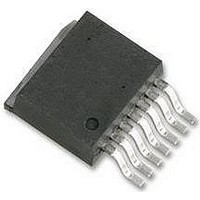LM22679TJ-ADJ National Semiconductor, LM22679TJ-ADJ Datasheet - Page 8

LM22679TJ-ADJ
Manufacturer Part Number
LM22679TJ-ADJ
Description
REGULATOR, ADJ. VOLTAGE, 5A 7TO263
Manufacturer
National Semiconductor
Datasheet
1.LM22679TJ-ADJ.pdf
(14 pages)
Specifications of LM22679TJ-ADJ
Primary Input Voltage
42V
No. Of Outputs
1
Output Current
5A
Voltage Regulator Case Style
TO-263
No. Of Pins
7
Operating Temperature Range
-40°C To +125°C
Svhc
No SVHC (15-Dec-2010)
Package
RoHS Compliant
Available stocks
Company
Part Number
Manufacturer
Quantity
Price
Company:
Part Number:
LM22679TJ-ADJ/NOPB
Manufacturer:
TI
Quantity:
16 500
www.national.com
As a first pass check, if the following equation holds true, a
given design is considered in a safe operating area and the
current limit will protect the circuit:
If the equation above does not hold true, the following sec-
ondary equation will need to hold true to be in safe operating
area:
If both equations do not hold true, a particular design will not
have an effective current limit function which might damage
the circuit during startup, over current conditions, or steady
state over current and short circuit condition. Oftentimes a
reduction of the maximum input voltage will bring a design into
the safe operating area.
Soft-Start
The soft-start feature allows the regulator to gradually reach
the initial steady state operating point, thus reducing start-up
stresses and surges. The soft-start can be adjusted by se-
lecting an external soft-start capacitor. An internal 50 µA
current source charges up the external soft-start capacitor.
The generated voltage is the voltage the internal reference
limits. If no external soft-start capacitor is used, there is an
internal soft-start feature with 500 µs (typical) start-up time.
Recommended soft-start capacitor values are between 100
nF to 1 µF.
Boot Pin
The LM22679 integrates an N-channel FET switch and as-
sociated floating high voltage level shift / gate driver. This gate
driver circuit works in conjunction with an internal diode and
an external bootstrap capacitor. A 0.01 µF ceramic capacitor
connected with short traces between the BOOT pin and the
SW pin is recommended to effectively drive the internal FET
switch. During the off-time of the switch, the SW voltage is
approximately -0.5V and the external bootstrap capacitor is
charged from the internal supply through the internal boot-
strap diode. When operating with a high PWM duty-cycle, the
buck switch will be forced off each cycle to ensure that the
bootstrap capacitor is recharged. See the maximum duty-cy-
cle section for more details.
Thermal Protection
Internal Thermal Shutdown circuitry protects the LM22679 in
the event the maximum junction temperature is exceeded.
When activated, typically at 150°C, the regulator is forced into
a low power reset state. There is a typical hysteresis of 15
degrees.
Internal Compensation
The LM22679 has an internal compensation designed for a
stable loop with a wide range of external power stage com-
ponents.
Insuring stability of a design with a specific power stage (in-
ductor and output capacitor) can be tricky. The LM22679
stability can be verified over varying loads and input and out-
put voltages using WEBENCH
ulation tool at www.national.com. A quick start spreadsheet
can also be downloaded from the online product folder.
V
IN
x T
BLK
x F < V
®
Designer online circuit sim-
OUT
x 0.724
8
The internal compensation of the -ADJ option of the LM22679
is optimized for output voltages below 5V. If an output voltage
of 5V or higher is needed, the -5.0 option with an additional
external resistor divider may also be used. The typical loca-
tion of the internal compensation poles and zeros as well as
the DC gain is given in Table 1. The LM22679 has internal
type III compensation allowing for the use of most output ca-
pacitors including ceramics.
This information can be used to calculate the transfer function
from the FB pin to the internal compensation node (input to
the PWM comparator in the block diagram).
For the power stage transfer function the standard voltage
mode formulas for the double pole and the ESR zero apply:
The peak ramp level of the oscillator signal feeding into the
PWM comparator is V
this modulator stage of the IC. The -5.0 fixed output voltage
option has twice the gain of the compensation transfer func-
tion compared to the -ADJ option which is 43.5dB instead of
37.5dB.
Generally, calculation as well as simulation can only aid in
selecting good power stage components. A good design prac-
tice is to test for stability with load transient tests or loop
measurement tests. Application note AN-1889 shows how to
easily perform a loop transfer function measurement with only
an oscilloscope and a function generator.
Application Information
EXTERNAL COMPONENTS
The following design procedures can be used to design a non-
synchronous buck converter with the LM22679.
Inductor
The inductor value is determined based on the load current,
ripple current, and the minimum and maximum input voltage.
To keep the application in continuous current conduction
mode (CCM), the maximum ripple current, I
less than twice the minimum load current.
The general rule of keeping the inductor current peak-to-peak
ripple around 30% of the nominal output current is a good
compromise between excessive output voltage ripple and ex-
cessive component size and cost. Using this value of ripple
current, the value of inductor, L, is calculated using the fol-
lowing formula:
Corners
DC gain
Zero 1
Zero 2
Pole 1
Pole 2
Pole 3
IN
/10 which equals a gain of 20dB of
TABLE 1.
Frequency
150 kHz
250 kHz
37.5 dB
1.5 kHz
100 Hz
15 kHz
RIPPLE
, should be











